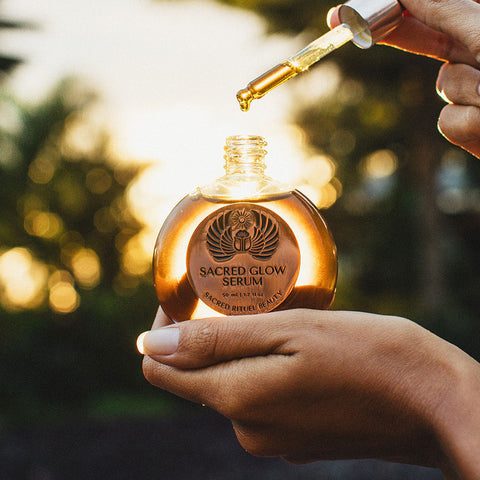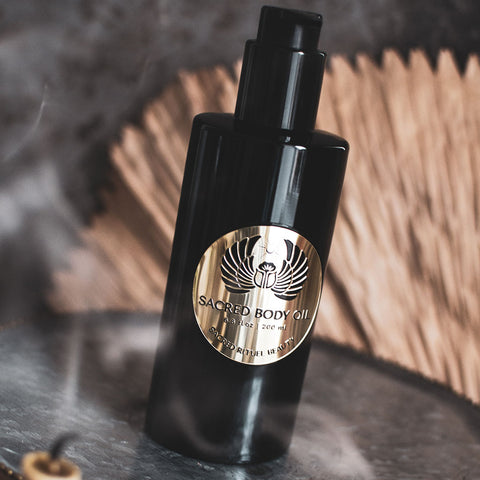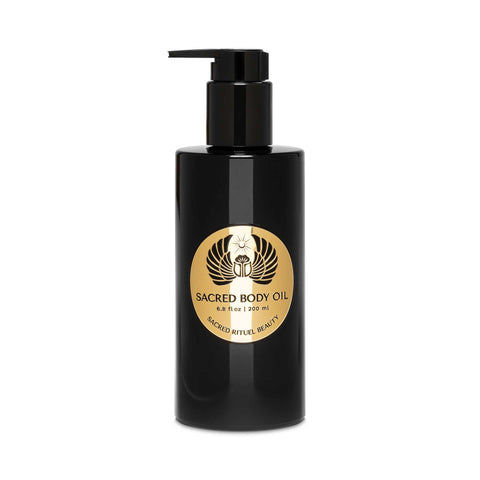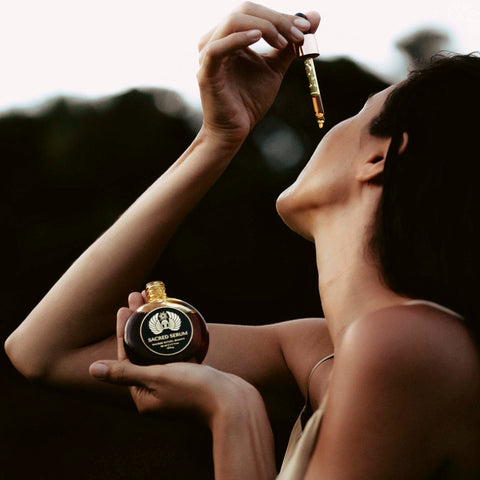
Prevent Winter Dry Skin Rash With Hydrating Body Oils
Key Takeaways:
- Hydrate with Body Oils: Hydrating body oils are essential for locking in moisture and preventing winter dry skin rash.
- Choose the Right Oil: Oils like jojoba, almond, and tamanu are particularly effective for soothing and nourishing winter skin.
- Layer and Apply Correctly: Applying body oils on damp skin after a shower ensures maximum hydration and protection from winter dryness.
Winter can be tough on our skin, often bringing dryness, flakiness, and the dreaded winter rash. For many, cold weather means more than just bundling up—it also means dealing with red, itchy, uncomfortable skin. This seasonal dryness isn’t just annoying; it can become painful if left unchecked. Luckily, there’s a simple solution to keep winter skin soft and healthy: hydrating body oils.
At Sacred Rituel, we create skincare with one goal in mind: to honor and protect your skin naturally. Using only pure, organic ingredients, we combine the best of nature and science to give you products that truly nourish. Our expertise in organic oils allows us to help you find relief from winter’s harsh effects and enjoy hydrated, healthy skin throughout the season.
In this guide, we’ll break down why winter dry skin rash happens, how body oils help, and easy tips to keep your skin happy all winter long.
Understanding Winter Dry Skin Rash: Why It Happens
Winter dry skin rash is a common skin issue that pops up when temperatures drop and humidity levels plummet. Cold air outside and heated air inside create an environment where moisture is constantly being pulled away from the skin. This moisture loss weakens the skin's natural barrier, leading to dryness, flakiness, and sometimes even inflammation. For some, this dryness can lead to an itchy, red rash, especially on areas like the arms, legs, and face.
The lack of moisture isn’t the only culprit; winter clothing, like wool sweaters, and longer, hot showers can also contribute to skin irritation. Combined, these factors make it challenging for our skin to stay hydrated and balanced during the colder months.
One way to combat winter dryness is with our Sacred Body Oil, crafted to nourish and deeply protect your skin's natural moisture barrier. Infused with rich, organic oils, it’s the perfect way to keep your skin hydrated and comfortable all season long. Discover the Sacred Body Oil and experience true winter relief.
Signs And Symptoms Of Winter Dry Skin Rash
Winter dry skin rash isn’t just about dry patches; it can come with a range of symptoms that make daily life uncomfortable. Some common signs to watch for include:
- Redness and Irritation: The skin may appear red or flushed, especially on sensitive areas like the cheeks, hands, and arms.
- Itchiness: One of the most common symptoms, this can lead to scratching, which further irritates the skin and may even cause small cuts or abrasions.
- Flakiness or Peeling: When the skin loses its moisture, it can start to peel or look flaky, particularly around the nose, forehead, and cheeks.
- Tightness: Dry, dehydrated skin often feels tight or uncomfortable, especially after washing or exposure to cold air.
- Small Cracks or Rough Patches: In more severe cases, winter rash can lead to tiny cracks on the skin’s surface, making it feel rough to the touch.
Recognizing these symptoms early can help you address and treat dry skin before it escalates into a painful rash.

Why Hydrating Body Oils Are Effective For Winter Skin
Hydrating body oils are a game-changer for winter skincare because they work with your skin’s natural structure. Unlike creams or lotions, which primarily add moisture to the skin’s surface, oils create a protective barrier that locks in moisture and prevents it from evaporating. This is especially important in winter when the skin’s natural barrier is often compromised by cold air and indoor heating.
Body oils are also packed with beneficial fatty acids, vitamins, and antioxidants that nourish the skin at a deeper level. Ingredients like jojoba oil, almond oil, and rosehip oil are known to closely mimic the skin’s natural oils, allowing for better absorption and hydration that lasts. Applying these oils after a shower, when your skin is still damp, helps seal in moisture and keeps skin soft, smooth, and resilient against winter’s drying effects.
Choosing The Right Body Oils For Dry Skin
Not all body oils are created equal when it comes to preventing winter dry skin rash. Choosing the right oils can make a noticeable difference in how well your skin handles the cold, dry air. Here are some top choices:
Jojoba Oil
Jojoba oil closely resembles our skin’s natural oils, making it especially effective at balancing moisture levels. It’s lightweight and non-comedogenic, meaning it won’t clog pores, which is ideal for those with sensitive or acne-prone skin. Jojoba also has anti-inflammatory properties, helping to calm irritated skin during winter.
Sweet Almond Oil
Packed with vitamins A and E, sweet almond oil provides vital nutrients that help support skin repair and cell turnover. Its gentle texture soothes itchiness and irritation, making it a go-to for relieving the discomfort of winter rash. Almond oil is also known for its quick absorption, leaving skin soft without feeling greasy.
Shea Nut Extract
Shea nut extract is an ultra-nourishing ingredient, loaded with vitamins A and E, essential fatty acids, and antioxidants that support skin hydration and healing. Its anti-inflammatory properties make it a soothing option for itchy or irritated skin, calming discomfort while adding moisture. In addition, shea nut extract helps strengthen the skin barrier, protecting it from further moisture loss in winter.
Tamanu Oil
Tamanu oil, extracted from the nut of the tamanu tree, is celebrated for its skin-regenerating and healing abilities. Known for its anti-inflammatory effects, it is deeply moisturizing and works to repair damaged or sensitive skin affected by cold weather. Tamanu oil also reduces redness and soothes dry patches, making it an excellent option for those prone to winter rashes.
Tips For Preventing Winter Dry Skin Rash
Prevention is key when it comes to winter dry skin rash. By incorporating a few habits into your daily routine, you can help your skin retain moisture and reduce the likelihood of developing dryness or rashes. Here are some practical tips:
Use A Humidifier
Indoor heating can zap moisture from the air, leaving your skin drier and more vulnerable to irritation. Using a humidifier in rooms where you spend the most time, like the bedroom or living room, can make a noticeable difference in keeping skin hydrated. It’s especially helpful to run a humidifier overnight to create a moisture-rich environment as your skin regenerates during sleep.
Take Warm, Not Hot, Showers
Hot water may feel amazing on a cold day, but it strips away the skin's natural oils, leading to dryness and irritation. Warm water is gentler on the skin and still provides a comfortable experience without compromising moisture. Aim to keep showers brief, ideally around 10-15 minutes, to further prevent dryness and avoid aggravating sensitive skin.
Pat Dry Instead Of Rubbing
When drying off after a shower, pat your skin gently with a soft towel rather than rubbing it, which can be abrasive and increase irritation. This method allows you to retain more of your skin's natural moisture, which is essential in cold, dry weather. Patting dry also leaves the skin damp, which is the perfect base for applying hydrating body oils right after.
Apply Body Oil While Skin Is Damp
After showering, applying body oil on slightly damp skin helps lock in moisture for longer-lasting hydration. Damp skin absorbs oils more effectively, allowing for deeper penetration into the skin’s layers. This simple step can make a big difference in preventing dryness and ensuring your skin stays soft and comfortable throughout the day.
Dress In Soft, Breathable Fabrics
Wool and other rough materials can irritate dry, sensitive skin, particularly in winter when skin is already more vulnerable. Instead, choose soft, natural fabrics like cotton or fleece for your base layers, as they are gentle and allow the skin to breathe. Layering these fabrics beneath warmer outerwear keeps skin comfortable and reduces friction, helping prevent rashes and irritation.
How To Apply Body Oils For Maximum Hydration
Applying body oil correctly can significantly enhance its effectiveness in keeping your skin hydrated and resilient against winter dryness. Here’s how to get the most out of your body oils:
Apply Right After Showering
The best time to apply body oil is within a few minutes of stepping out of the shower, as your skin is primed to absorb moisture. Pat your skin gently to remove excess water, but leave it slightly damp, which helps to seal in the moisture. This simple step can enhance the effectiveness of the oil, making your skin feel softer and more hydrated throughout the day.
Use Small Amounts
Body oils are potent, so a little bit goes a long way, and starting with a small amount prevents over-saturation. Apply a small drop to your palm, warm it up between your hands, and then spread it evenly across your skin. This way, you avoid a greasy residue and ensure even application for optimal hydration.
Massage Gently
Taking a few moments to massage the oil in circular motions helps stimulate circulation and enhances absorption. This technique not only improves how well the oil penetrates the skin but also leaves it feeling soothed and relaxed. Massaging also promotes a subtle glow, giving your skin a fresh, healthy appearance.
Focus On Dry Areas
Certain areas, like elbows, knees, and feet, are more prone to winter dryness and may need extra care. Apply a slightly thicker layer to these areas, massaging it in thoroughly to lock in moisture. This focus helps prevent rough patches and keeps these trouble spots feeling soft and smooth.
Let It Absorb Before Dressing
Allowing the oil a few minutes to fully absorb before dressing ensures it has time to sink into your skin. This reduces the likelihood of it transferring onto your clothes and helps you get the most out of its moisturizing effects. By giving it time to settle, you can enjoy smoother skin without the risk of feeling oily.
Other Skincare Tips To Keep Your Skin Hydrated In Winter
While body oils are incredibly effective, combining them with other skincare practices can help ensure that your skin stays hydrated and healthy throughout winter. Here are some additional tips to support your winter skincare routine:
Opt For Gentle Cleansers
Many traditional cleansers contain harsh chemicals that strip away the skin’s natural oils, leaving it more vulnerable to dryness. Using a gentle, sulfate-free, and fragrance-free cleanser can help protect your skin’s moisture barrier. This small switch can make a big difference in how your skin feels after each wash, especially in winter.
Use A Hydrating Toner And Serum Combo
After cleansing, start with an alcohol-free, hydrating toner to balance your skin’s pH and add an initial layer of moisture. Follow it up with a serum rich in ingredients that deliver deep hydration. This combination preps your skin to better absorb body oils or moisturizers, enhancing overall moisture retention.
Exfoliate Weekly
Exfoliating helps remove dead skin cells that can build up and create a rough, flaky texture. However, in winter, it’s best to exfoliate only once a week to avoid irritating already dry skin. Choose a mild exfoliant or a soft washcloth to keep skin smooth without overdoing it.
Layer Moisturizers With Oils
For an extra layer of hydration, try applying a light moisturizer first, followed by a body oil. This layering technique traps moisture, keeping your skin feeling soft and supple throughout the day. It’s especially useful for areas prone to extreme dryness, like hands and feet.
Stay Hydrated
Drinking plenty of water supports your skin’s natural hydration levels from the inside out, which is essential for winter wellness. When your body is well-hydrated, it’s easier for your skin to retain moisture on the surface. Aim for regular water intake to keep your skin looking fresh and healthy.

Eat Healthy Fats
Including foods rich in omega-3 and omega-6 fatty acids, like avocado, salmon, and walnuts, can boost your skin’s natural lipid barrier. These healthy fats improve skin’s elasticity and resilience, making it less prone to winter dryness. By adding these to your diet, you can support overall skin health and hydration.
Final Thoughts
Winter dry skin rash doesn’t have to be an unavoidable part of the season. With a thoughtful approach to skincare, you can protect your skin against the cold, dry air and maintain a soft, hydrated complexion. Hydrating body oils are a powerful tool in combating winter dryness, offering deep hydration and a natural way to lock in moisture. By choosing the right oils, applying them correctly, and supporting your skin with other nourishing habits, you can keep winter skin woes at bay.
Embrace these simple steps, and you’ll be ready to enjoy the winter season without the discomfort of dry skin. A little extra care goes a long way in helping your skin feel healthy, comfortable, and resilient—even on the chilliest days.
Read also:
- Why You Need A Redness Reducing Serum For Irritated Skin
- Using Facial Oils To Tackle Hormonal Acne Naturally
- How To Properly Use Facial Oil For Healthy Skin
Frequently Asked Questions About Winter Dry Skin Rash
Can winter dry skin rash go away on its own?
In mild cases, it can improve as you adapt your environment and skincare, but in severe cases, additional hydration and treatment may be needed to soothe and heal the skin.
Is winter dry skin rash the same as eczema?
No, while they share symptoms, winter dry skin rash is generally caused by environmental factors, whereas eczema is a chronic skin condition often linked to immune responses.
Can diet affect winter dry skin?
Yes, a diet rich in omega-3 and omega-6 fatty acids, vitamins, and hydration can improve skin health and help it retain moisture, which can prevent dryness.
How long does it take to see improvement in winter dry skin rash with body oils?
With regular use of body oils and a consistent skincare routine, many people notice improvement within a few days to a week.
Can I use body oils on my face to prevent winter dryness?
Yes, some body oils, like jojoba and argan oil, are suitable for facial use. However, always patch test to ensure they won’t clog pores or cause irritation.
What clothing materials can help prevent winter dry skin rash?
Soft, breathable materials like cotton or moisture-wicking fabrics are ideal. Avoid rough wool or synthetic fabrics that can irritate dry skin.
How can I prevent winter dry skin rash on my hands?
Use a gentle hand soap, avoid overly hot water, apply hand cream regularly, and wear gloves in cold weather to lock in moisture and prevent dryness.
Are there any medications that help with winter dry skin rash?
For severe cases, a doctor may recommend topical corticosteroids or prescription moisturizers. However, most cases respond well to a consistent moisturizing routine.
Sources:
- Engebretsen, K. A., Johansen, J. D., Kezic, S., Linneberg, A., & Thyssen, J. P. (2015). The effect of environmental humidity and temperature on skin barrier function and dermatitis. Journal of the European Academy of Dermatology and Venereology, 30(2), 223–249. https://doi.org/10.1111/jdv.13301
- Rodrigues, L., Palma, L., Tavares Marques, L., & Bujan Varela, J. (2015). Dietary water affects human skin hydration and biomechanics. Clinical, Cosmetic and Investigational Dermatology, 8(8), 413. https://doi.org/10.2147/ccid.s86822
- Skin Care and Aging. (2017, October 1). National Institute on Aging. https://www.nia.nih.gov/health/skin-care/skin-care-and-aging







Comments (0)
There are no comments for this article. Be the first one to leave a message!